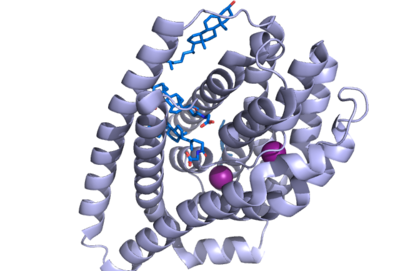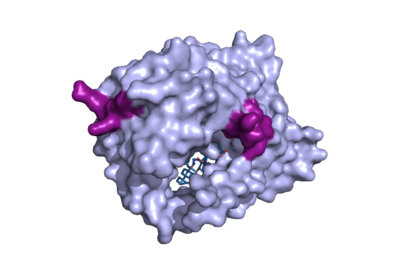Background

Figure 1. NTCP structure with both Na ions and bile salts bound. PDB file 7ZYI.
- Sodium taurocholate co-transporting polypeptide (NTCP) is a sodium-dependent transporter in the body that is responsible for the transportation of bile salts from the blood into epithelial liver cells. This carrier protein is responsible for a conformational change that allows bile salts to cross the cell membrane and enter the inside of liver cells. [1]. Both sodium ions and bile salts bind to NTCP in the same binding pocket on the molecule (Fig. 1). NTCP also acts as a receptor for Hepatitis B virus and Hepatitis D virus. The bile salts transported by NTCP are located within the gastrointestinal tract of the body and play a very key role in many biological functions. These functions include digesting and absorbing nutrients by helping break down fats and transporting lipid soluble nutrients into the liver. [2]. The NTCP carrier protein itself can be found within hepatocytes, or the epithelial cells of the liver, but more specifically, within the basolateral membrane of these cells. [3]. The uptake of bile salts into the liver also allow for drugs to be both absorbed and excreted, as well as essential nutrients such as Vitamin A,D,E, and K to be absorbed in the small intestine.
Structural Overview
Tatiana
Function
Olivia
Binding Pocket
- The NTCP binding pocket represents a "tunnel" lined with hydrophilic residues within the NTCP structure to allow hydrophilic bile salts and sodium ions to bind. When there are no bile salts bound to NTCP's binding tunnel, it forms a hollow hole in the middle of the structure, from to . As bile salts bind to this binding pocket, the bile salts very nicely fill the hole within NTCP and fit almost perfectly within the tunnel, to the point where the can no longer be seen, as it is completely encompassing the bile salts. This tunnel formed connects the external cytoplasm of the hepatocyte to the inner leaflet of the basolateral membrane. The side of the tunnel where the bile salts bind are lined with hydrophilic residues, whereas the opposite side of the helix is lined with hydrophobic residues, as the transmembrane helices are amphipathic. [4].

Figure 1. Surface representation of the NTCP molecule with both patches shown. Patch 1 can be seen on the left side of the molecule, whereas patch 2 is located on the right side within the binding tunnel. PDB file 7ZYI.
- The binding pocket of NTCP contains two patches on its exterior. These two patches are used for assisting in the binding of bile salts into the binding tunnel. These external patches are extremely important for aiding in the transport of bile salts from the exterior of NTCP to the interior binding tunnel [3]. Patch 1 is made up of residues 84-87 of NTCP and Patch 2 consists of residues 157-165. Patch 1 is located on the poles of NTCP, namely the top of the structure, within the TM2-TM3 transmembrane loop, whereas patch 2 is located towards the middle of the NTCP molecule within transmembrane 5 (TM5). These two patches are also predominantly responsible for binding the preS1 binding region of the HBV/HDV virus. Patch 2 also forms a part of the binding tunnel previously mentioned [3].
Mechanism
Olivia
Significance
Olivia
HBV/ HDV
Tatiana
This is a sample scene created with SAT to by Group, and another to make of the protein. You can make your own scenes on SAT starting from scratch or loading and editing one of these sample scenes.


